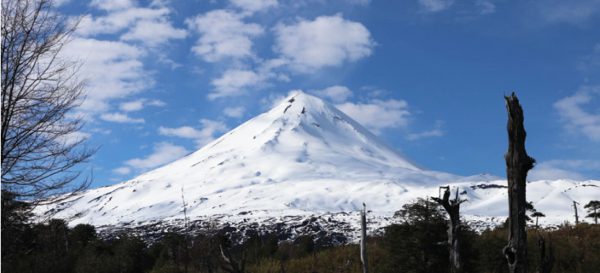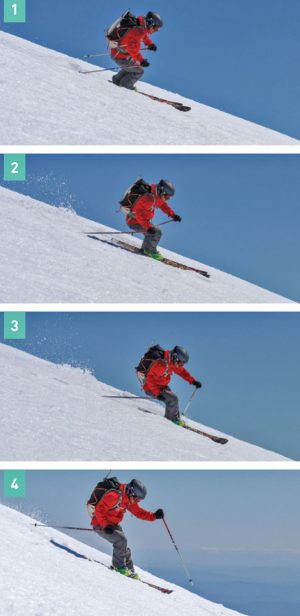Let’s be honest. We all faceplant from time to time. While it’s tempting to blame the snow, the root cause is really our failure to anticipate changes in the snow and therefore change our approach.
by Nigel HARISON CSIA III, CSCF II * photos: SECTION 8 SNOWSPORTS * snow: Villarica and Llaima volcanoes, Chile
Any given run in the backcountry may require you to move from crud to powder, corn, chalk or ice. Most skiers have experienced these snow conditions and can describe the feeling of skiing them. For instance, ice can cause rapid acceleration and the feeling of the feet getting away from you. Chalk might feel “grabby” and you find your skis juddering at the bottom of the turn. Crud can make it hard for the skis to start turning toward the fall line.
While all these conditions can present different challenges, they are all manageable when encountered in isolation. So if you’re dealing with a long, consistent pitch of crud, you’ll find some method of dealing with it by the time you’ve made a few turns.
An experienced skier can predict changes in the snow while on the move, before skiing from one surface to the next. The ability to do this effectively is based on the ability to take information from the following various sources and process it.
ASPECTS:
Many people can stand in the car park, or look at a weather chart, and predict which aspects (or faces, e.g. west) of a given hill will offer the best skiing on any particular day. These predictions are made based on past and present weather, particularly temperature, precipitation, wind speed and direction.
ASPECTS WITHIN ASPECTS:
On any given face of a hill there are many smaller slopes formed by gullies, ridges, rock buttresses and other landscape features. All these have an effect on snow, altering, for example, exposure to wind and sun. A shady side of a gully may have collected vast amounts of snow through cross loading (wind blowing across a slope and depositing snow on the lee sides of ridges), while the other side of the gully may have been cooked by the sun and scoured by wind to leave a surface of ice.
TIME:
Early in the morning a gully may offer great powder on the shady side (assuming the slope and conditions are safe) and great corn on the sunny side in the afternoon. An experienced skier will know when a particular aspect and surface is likely to be good.
VISUAL OBSERVATIONS OF SNOW SURFACES:
Look carefully at the snow on ascent, or even during descent, and note changes in snow appearance. These changes can be subtle, such as a twinkling surface of powder to a more matte appearance of slabby or chalky snow. Other surfaces are less subtle and easier to spot, for instance, wind-shaped hard snow or Zastrugi.
FEEL:
A skier can feel changes as he moves from one snow type to the next. For instance, as snow becomes denser or wetter, the tips will not float as easily as they do in powder.
THE BIG QUESTION: HOW TO ADAPT?
It all boils down to stance and balance. A strong stance, with balance centred over the arch and therefore waist of the ski, will go a long way to helping you deal with changes in snow quality. Bringing the shoulders forward and engaging the core muscles will help maintain stability and prevent you from being thrown forward, or backward, as your skis slow or accelerate under you.
Once this foundation is present, minor adjustments can be made to adapt to changing snow, such as moving from hard snow, where a wider stance is effective, to powder, where a shift to a slightly narrower stance might be required. When entering wetter, slower (or simply deeper) snow, you might need to push your feet slightly forward at the end of the turn to anticipate the slowing of the skis relative to the body.
Go out and experiment. Find areas of the hill that offer varying snow conditions and see how it feels to move from one to the other. Take the time to notice where areas of different snow are to be found, and why. This is time well spent.
And one last thing! Leaning back in powder is a myth. Leaning back will only take weight off the tips of your skis (necessary to initiate your turns) and get you out of balance. And why would you want to put yourself out of balance? This idea might have come from photos that show skiers with their knees bent and just the tips of the skis poking out of the snow. This isn’t the skier leaning back. This is the skier moving his skis forward and allowing them to rise to do…guess what?
Ski Canada instruction editors NIGEL HARISON and TOBIN LEOPKEY are Program Directors at Section 8 Snowsport Institute which offers ski improvement camps for intermediate and expert skiers in all terrain and conditions in B.C., the Alps, Japan and Chile. www.section8ski.com

